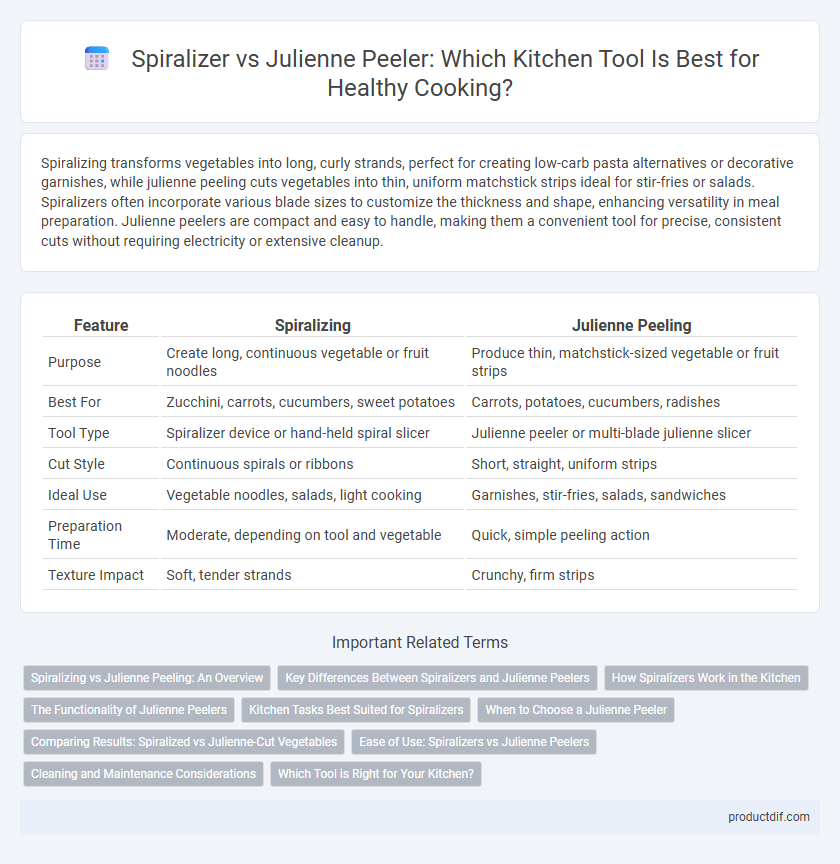Spiralizing transforms vegetables into long, curly strands, perfect for creating low-carb pasta alternatives or decorative garnishes, while julienne peeling cuts vegetables into thin, uniform matchstick strips ideal for stir-fries or salads. Spiralizers often incorporate various blade sizes to customize the thickness and shape, enhancing versatility in meal preparation. Julienne peelers are compact and easy to handle, making them a convenient tool for precise, consistent cuts without requiring electricity or extensive cleanup.
Table of Comparison
| Feature | Spiralizing | Julienne Peeling |
|---|---|---|
| Purpose | Create long, continuous vegetable or fruit noodles | Produce thin, matchstick-sized vegetable or fruit strips |
| Best For | Zucchini, carrots, cucumbers, sweet potatoes | Carrots, potatoes, cucumbers, radishes |
| Tool Type | Spiralizer device or hand-held spiral slicer | Julienne peeler or multi-blade julienne slicer |
| Cut Style | Continuous spirals or ribbons | Short, straight, uniform strips |
| Ideal Use | Vegetable noodles, salads, light cooking | Garnishes, stir-fries, salads, sandwiches |
| Preparation Time | Moderate, depending on tool and vegetable | Quick, simple peeling action |
| Texture Impact | Soft, tender strands | Crunchy, firm strips |
Spiralizing vs Julienne Peeling: An Overview
Spiralizing creates long, continuous strands of vegetables, ideal for healthy, low-carb noodle substitutes, while julienne peeling produces thin, matchstick-sized strips perfect for salads and garnishes. Spiralizers typically handle firm vegetables like zucchini and carrots efficiently, enabling uniform spiral cuts, whereas julienne peelers provide precision for finer, consistent cuts. Both techniques enhance presentation and texture in dishes, but spiralizing emphasizes volume and shape, contrasting with the julienne's focus on delicate, slender slices.
Key Differences Between Spiralizers and Julienne Peelers
Spiralizers create long, continuous vegetable ribbons ideal for dishes like zucchini noodles, while julienne peelers produce thin, uniform strips perfect for garnishes or salads. Spiralizers typically handle larger produce and offer multiple blade options for varied spirals, whereas julienne peelers are handheld tools designed for quick, precise strips. Choosing between the two depends on desired texture, volume, and presentation in culinary applications.
How Spiralizers Work in the Kitchen
Spiralizers transform vegetables into continuous, spiral-shaped ribbons by using a sharp blade and rotational motion, making them ideal for creating low-carb pasta alternatives and artistic garnishes. Unlike julienne peelers that produce thin, straight strips by manual slicing, spiralizers automate and enhance precision with adjustable blade settings for varied noodle thicknesses. This kitchen tool efficiently processes firm vegetables like zucchini, carrots, and cucumbers, reducing prep time while elevating healthy meal presentation.
The Functionality of Julienne Peelers
Julienne peelers excel in creating uniform, thin strips of vegetables, ideal for salads, garnishes, and stir-fries, enhancing both texture and presentation. Their sharp, serrated blades effortlessly slice through firm produce like carrots, zucchini, and cucumbers, allowing precise control over strip thickness. Unlike spiralizers that produce continuous spirals, julienne peelers offer versatility for detailed culinary tasks and easier cleaning.
Kitchen Tasks Best Suited for Spiralizers
Spiralizers excel at creating long, continuous vegetable ribbons, making them ideal for preparing zucchini noodles, curly fries, and decorative garnishes. They handle softer vegetables like zucchini, cucumbers, and carrots efficiently, transforming them into visually appealing, uniform spirals. Unlike julienne peelers, spiralizers reduce prep time and produce consistent shapes perfect for salads, stir-fries, and low-carb pasta substitutes.
When to Choose a Julienne Peeler
Choose a julienne peeler when you need uniformly thin, ribbon-like vegetable strips ideal for salads, garnishes, or stir-fries. This tool excels with firm vegetables like carrots, zucchini, and cucumbers, providing consistent texture and presentation. Unlike spiralizers, julienne peelers offer precise control for intricate cuts without requiring large, round vegetables.
Comparing Results: Spiralized vs Julienne-Cut Vegetables
Spiralized vegetables create long, curly ribbons that enhance texture and presentation, ideal for dishes like salads and pasta substitutes. Julienne-cut vegetables yield thin, uniform sticks that provide a consistent bite and are perfect for stir-fries or garnishes. Both methods preserve the vegetable's freshness but differ in visual appeal and mouthfeel, influencing recipe versatility and cooking time.
Ease of Use: Spiralizers vs Julienne Peelers
Spiralizers offer a user-friendly approach with ergonomic handles and straightforward mechanisms, enabling quick transformation of vegetables into uniform spirals. Julienne peelers, while compact and easy to maneuver, require more precision and effort to achieve consistent thin strips, making them less suited for high-volume tasks. For ease of use in creating intricate vegetable cuts, spiralizers provide a more efficient and less labor-intensive solution than julienne peelers.
Cleaning and Maintenance Considerations
Spiralizers with removable, dishwasher-safe blades offer easier cleaning compared to traditional julienne peelers, which require meticulous hand washing to remove stuck vegetable residues. Julienne peelers often have narrow grooves that accumulate food particles, necessitating thorough scrubbing to maintain hygiene and prevent rust. Selecting stainless steel tools can reduce maintenance time due to their rust-resistant properties and simpler cleaning process.
Which Tool is Right for Your Kitchen?
Spiralizers create long, continuous vegetable ribbons ideal for dishes like zucchini noodles, while julienne peelers produce thin, uniform strips perfect for garnishes and salads. Selecting the right tool depends on your cooking style and the texture you want; spiralizers excel in making pasta-like shapes, whereas julienne peelers offer precision and ease for smaller cuts. Consider the types of vegetables you frequently use and the presentation you prefer to determine which kitchenware best fits your culinary needs.
Spiralizing vs Julienne peeling Infographic

 productdif.com
productdif.com